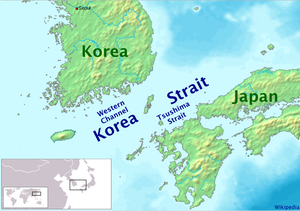Tsushima Strait(Đối mã eo biển,Tsushima Kaikyō)[1]orEastern Channel[2](동수로 Dongsuro) is a channel of theKorea Strait,which lies betweenKoreaandJapan,connecting theSea of Japan,theYellow Sea,and theEast China Sea.

The strait is the channel to the east and southeast ofTsushima Island,with the Japanese islands ofHonshuto the east and northeast, andKyushuand theGotō Islandsto the south and southeast. It is narrowest south-east ofShimono-shima,the south end ofTsushima Islandproper, constricted there by nearbyIki Island,which lies wholly in the strait near the tip ofHonshu.South of that point Japan'sInland Seamingles its waters through the narrowKanmon StraitbetweenHonshuandKyushu,with those of the Eastern Channel, making for some of the busiest sea lanes in the world.
The Strait was the site of the decisive naval battle in theRusso-Japanese War,theBattle of Tsushima,between the Japanese and Russian navies in 1905, in which the Russian fleet was virtually destroyed.[3]
Geography
editThe Tsushima Strait measures approximately 100 kilometres alongTsushima Islandand is about 65 kilometres wide at its narrowest. The strait has a depth of about 140[4]metres and is bounded by theTsushima Islandsto the west through north (ofGotō Islands). NearbyIki Islandlies in the strait about 50 kilometres towardsKyūshūfrom the southern tip ofKamino-shima(South Island).
A warm branch of theKuroshio Currentpasses through the strait. Originating along the Japanese islands, this current passes through theSea of Japanthen a branch eventually flowing into the Northern Pacific Ocean via theTsugaru Straitsouth ofHokkaido.Another branch continues far northward and divides along either shore ofSakhalin Island;eventually flowing into theSea of Okhotskvia theLa Perouse Straitnorth of Hokkaido and via theStrait of Tartaryinto the Sea of Okhotsk north of Sakhalin Island nearVladivostok.
TheKuroshio Currentbrings rich fisheries resources from the East China Sea into the Sea of Japan, likeJapanese amberjack,Japanese horse mackerel, but these days also brings disaster like mass aggregation of giganticNomura's jellyfishandwastefrom countries along the course of the current.
A commercial ferry service operates betweenShimonosekiat the western tip of Honshu and Busan (aka Pusan), South Korea. Another operates between Shimonoseki andTsushima Island.The cities ofKitakyushu(Kyushu) and Shimonoseki (Honshu) are joined by an ocean-spanning bridge across theKanmon Straitjoining those cities withNagasaki,which latter city serves as prefecture-level capital and administers both Tsushima and Iki Island. The Kanmon Strait lies approximately 85 miles (135 km) due east of the center of Tsushima Island, while Nagasaki city proper lies about 100 miles (165 km) to the south-south-east of the southern tip of the island.
Historical impact
editThe earliest settlement of Japan by people most resembling modern Japanese in littoral northern Kyushu next to the Eastern Channel is supported by legendary, historical, and archeological evidence, and is undisputed. A range of dates when immigration began from what is the mainland via the Korean Peninsula to north Kyushu from the fall ofFour Commanderies of Han(108 BC) to the 4th century AD. Historically these narrows (i.e., the whole Korea/Tsushima Strait) served as a highway for high-risk voyages (southern end of the Korean Peninsula to the Tsushima Islands to Iki Island to the western tip of Honshu) for trade between the countries of the Korean peninsula and Japan.
The straits also served as a migration or an invasion path, in both directions. For example, archeologists believe the firstMesolithicmigrations (Jōmon) traveled across to Honshu around the 10th century BC, supplantingPaleolithicpeople that walked from Asia to Japan overland over 100,000 years ago when the sea level was lower during thePleistoceneice age.Immigrants fromKoreaandChinaalso contributed to waves of immigrants arriving in Kyushu, although who, when, and how many exactly is a matter of intense debate.Buddhism,along with Chinese writing, was initially transmitted from Korean Peninsula via Eastern Channel to Japan in the 5th century by way of the straits as well. Iki to Kamino-shima, the southern end of the large island of Tsushima, is about 50 kilometres.Busan(Korea), to the northern tip of Tsushima, about the same across the Korea Strait. These were tremendous distances to attempt in small boats over open seas.
TheMongol invasions of Japancrossed this sea and ravaged the Tsushima Islands before thekamikaze– translated as "divine wind" – atyphoonthat is said to have saved Japan from aMongolinvasion fleet led byKublai Khanin 1281. The 16th century,Toyotomi Hideyoshiwas aimed at the conquest of China via the Korean Peninsula from this strait.
The decisive naval battle in theRusso-Japanese War,theBattle of Tsushima,took place in the strait between the Japanese and Russian navies in 1905; the Russian fleet was virtually destroyed by a Japanese naval force for the loss of only three Japanesetorpedo boats.[3]
Japan'sterritorial watersextend to three nautical miles (5.6 km) into the strait instead of the usual twelve, reportedly to allownuclear-armedUnited States Navywarships and submarines to transit the strait without violating Japan's prohibition against nuclear weapons in its territory.[5][6]
See also
editReferences
edit- ^"Korea Strait".Encyclopedia Britannica.Retrieved2018-04-03.
The strait, which is 300 feet (90 m) deep, is bisected by the Tsushima islands, the passage to the east being often referred to as Tsushima Strait.
- ^"The World Factbook: Japan - Geography".CIA.Retrieved2018-02-13.
between 3 nm and 12 nm in the international straits - La Perouse or Soya, Tsugaru, Osumi, andEastern and Western Channelsof the Korea or Tsushima Strait
- ^ab100 Battles,Decisive Battles that Shaped the World,Dougherty, Martin, J., Parragon, p.144-45
- ^Imamura, K. 1996. Prehistoric Japan: New Perspectives on Insular East Asia. London, University College London.
- ^Kyodo News,"Japan left key straits open for U.S. nukes",Japan Times,June 22, 2009.
- ^See:"Enforcement Order of the Law on the Territorial Sea and the Contiguous Zone (Cabinet Order No. 210 of 1977, as amended by Cabinet Order No. 383 of 1993, Cabinet Order No. 206 of 1996 and Cabinet Order No. 434 of 2001)"(PDF).Law of the Sea Bulletin(66): 71–81. 13 March 2008.